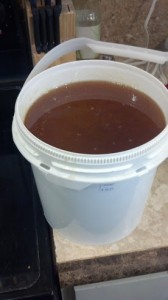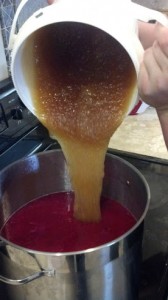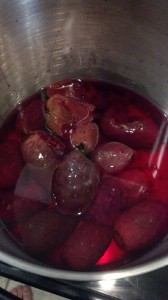
Have you ever had a day where you were tired of beer? Me neither, but there have been times where I would have loved something sweet to sip on after a nice day of brewing. There have also been times when I run into the non-beer drinker. I don’t like to leave anyone out of the home brew fun and mead is a great drink for those who don’t have a taste for beer. So I’m going to tell you a little about mead.
Mead is arguably the oldest known form of fermented beverage known to mankind. Dating back to thousands of years BC. And it is one of the simplest brews out there. Mead, if you don’t know, is just water and fermented honey. Meads do not all require boiling, and you can make mead in your regular fermentation vessels in a couple of weeks or you can ferment the meads for a month or so. It is a very versatile beverage.
What is Mead?
Mead is not really a beer and not really a wine. Good mead is in the 10-14% alcohol like a wine but is lightly carbonated like a beer. Though you can make still mead which is not carbonated or still mead that is more like a wine. Though carbonation is not required in mead, it does in my opinion help out with the flavor of the drink. A standard Mead uses honey and water but you can add any flavor you want to the mead. It is one of the most versatile drinks out there. I have seen strawberry, watermelon, sour cherry, blueberry, gingerbread and even BACON mead! The possibilities are endless.
Base Mead
To be able to make all of these crazy mead flavors you need to be able to make a good base mead. The main difference between all standard meads is the honey used to make the mead. I always thought “honey was honey” until I learned of mead making. It turns out that depending on where the bees are from, you can end up with very different tasting mead. It all comes down to what the bees were using to make the honey or what general flower they visited most.

When you go to look for your honey you will see wildflower honey, orange blossom honey, or even desert flower honey. These are all the flowers that the bees were let loose on to produce the honey. The honey that you use will always give you subtle flavors of wherever that honey came from. Thus making some mead different from others that used different honey. It takes anywhere from 10-18 or more lbs. of honey for a five gallon batch depending on the desired strength.
Flavored mead
If you decide to make flavored mead (other than standard honey mead) you can do a few things to achieve this. You can either buy some flavored syrup and add that to the mead until you reach the required taste or if you prefer the more natural method you can add fresh fruits to your mead. You can also make spiced meads by adding regular cooking spices for example, in the making of apple pie mead or gingerbread mead.

Adding special flavors can be tricky at times because you are putting foreign matter into a fermenter. These times are always tough on the nerves, praying that you didn’t contaminate your brew. A good rule of thumb is that if it’s syrup that you are adding from a commercial bottle you should be ok. If you are adding fresh fruit you should first boil the fruit in with the honey for five to ten min before fermentation. The same goes for dry spices. These are a couple ways to protect from contamination. Like I said earlier meads do not always require boiling.
Yeast and mead
One other important thing to remember about mead is its high alcohol content. Since it ranges from ten to upwards of eighteen percent you cannot use standard beer yeasts to ferment it. You will have to use wine yeast or even champagne yeast to be able to ferment the yeast fully. Something with an alcohol tolerance equal or a little higher to the level you are trying to reach. I also like to make my mead as clear as possible so I use high flocculation yeasts. Flocculation is a fancy word for your yeasts ability to clump up and drop out to the bottom of the fermenter leaving a cleaner finished product. Filtering is also an option but I prefer not to go through the trouble.
Mead also ages very well. Many people won’t even touch there mead until it has sat for a year or more. But it is perfectly fine to drink your mead right after fermentation. Keep a couple bottles for later to see what happens.
Well there you have it. Mead is a wonderful and delicious concoction that should allow you to please your own pallet as well as some of the sweeter pallets out there that some people have. It is a great gift during the holidays and also for special occasions like Valentine’s day and weddings. Whatever you brew your mead for I hope you enjoy it as much as I do and continue brewing it in the future.


